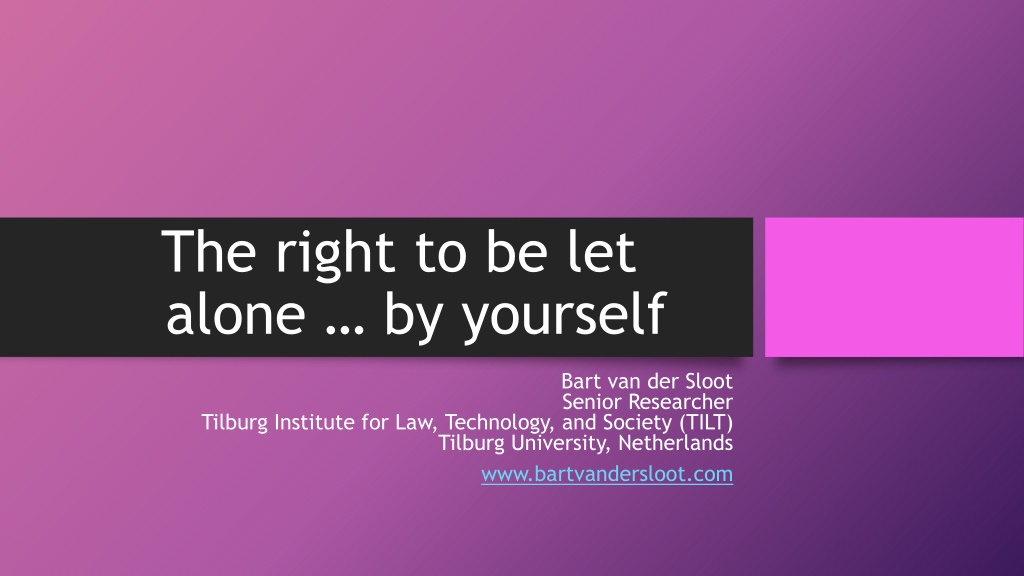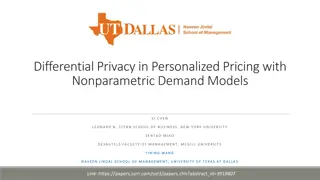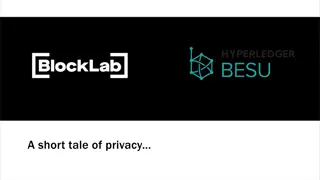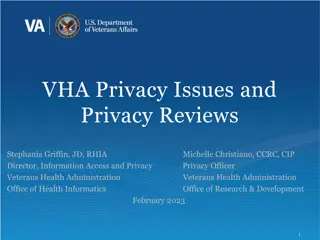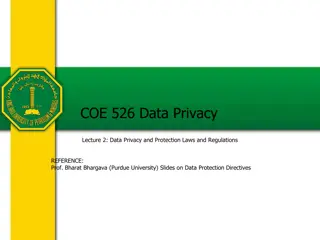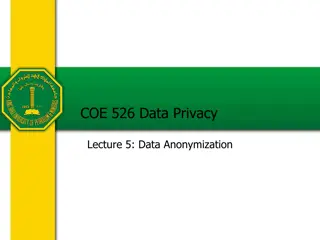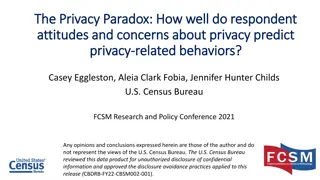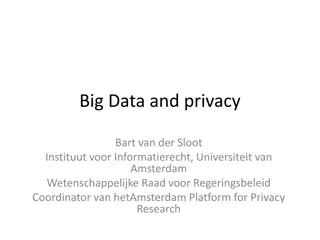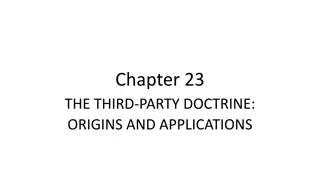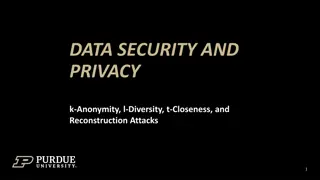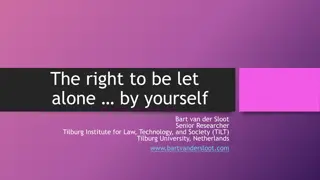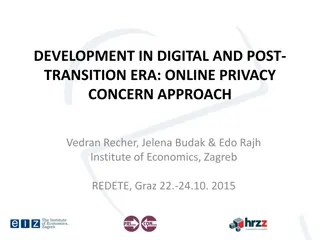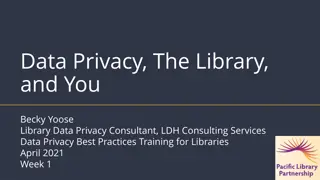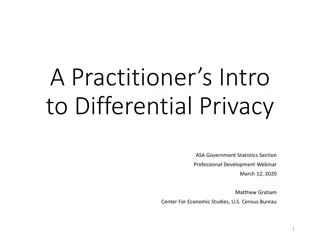Understanding Common Definitions of Privacy in Europe
This informative content explores the various aspects of privacy, including definitions by prominent scholars such as Warren and Brandeis, Westin, and others. It delves into the constitutional and horizontal protection of privacy in Europe, highlighting the rights of individuals regarding their private and family life, as well as the correlation between rights and duties. Additionally, it addresses arguments challenging the legitimacy of individual claims to privacy.
Uploaded on Sep 12, 2024 | 0 Views
Download Presentation

Please find below an Image/Link to download the presentation.
The content on the website is provided AS IS for your information and personal use only. It may not be sold, licensed, or shared on other websites without obtaining consent from the author. Download presentation by click this link. If you encounter any issues during the download, it is possible that the publisher has removed the file from their server.
E N D
Presentation Transcript
The right to be let alone by yourself Bart van der Sloot Senior Researcher Tilburg Institute for Law, Technology, and Society (TILT) Tilburg University, Netherlands www.bartvandersloot.com
Common definitions of Privacy These considerations lead to the conclusion that the protection afforded to thoughts, sentiments, and emotions, expressed through the medium of writing or of the arts, so far as it consists in preventing publication, is merely an instance of the enforcement of the more general right of the individual to be let alone. Warren and Brandeis, 1890. Privacy is the claim of individuals, groups, or institutions to determine for themselves when, how, and to what extent information about them is communicated to others. Westin, 1967 Privacy is the capacity to negotiate social relationships by controlling access to information about oneself. Agre & Rotenberg, 1998.
Common definitions of Privacy Constitutional protection of privacy in Europe: Everyone has the right to respect for his private and family life, his home and his correspondence. There shall be no interference by a public authority with the exercise of this right except . Article 8 European Convention on Human Rights. Horizontal protection of privacy in Europe: Any person who has suffered material or non-material damage as a result of an infringement of this Regulation shall have the right to receive compensation from the controller or processor for the damage suffered. Article 82 General Data Protection Regulation.
Common definitions of Privacy: privacy can be invoked vis-a-vis others Indivdiuals Individual Companies Government
The individual has a right only in so far it correlates with the duties of others and the other way around Indivdiuals Individual Companies Government
Ways to problematize the correlation between rights (indvidual) and duties (others) Indivdiuals Individual Companies Government
The individual has no legitimate claim to privacy (nothing to hide argument) Indivdiuals Individual Companies Government
The individuals claim to privacy is realy to conceal mischief towards others (e.g. feminist critique) Indivdiuals Individual Companies Other individuals Government
The individuals claim to privacy is in itself legitimate, but negatively effects others (network effect) Indivdiuals Individual Companies Other individuals Government
Privacy is not about the individual(s interests) only, it is about a group of society as a whole Indivdiuals Individual Companies Societal interest Government
The violation of the individuals privacy is systemic, i.e. there is no concrete other ? Individual ? ?
Others have (virtue) duties to protect the individual s privacy, irrespective of rights Indivdiuals Individual Companies Government
The individual has (virtue) duties to protect her own privacy Individual Herself
The right to be let alone . by yourself Individual Herself
Problem: self-conflict (I is not uniform) Past: A photo stored on the web may confront a person with a particular aspect of her past that she has long forgotten about (an old love affair; an experimental gothic phase; an anorexic period) Present: Personalised content may confront a person with information she was unaware of herself (a Big Data company may infer an adolescent s sexual preference on the basis of the music taste of online friends, while she may not want to find out by a newsletters that presume a certain sexual preference Future: Data-analytics may accurately predict a person s future, while she may want to remain oblivious (e.g. a FitBit company informing a person that she is likely to suffer from Type 2 Diabetes if she continues her inactive lifestyle).
Problem: wanting to retain psychological unity There is an important difference between, on the one hand, the fact that I do not want you to know that I had an anorexic period when I reached puberty, and on the other hand, the fact that I do not want to be confronted with such information myself, because I want to forget about that painful period and move on with my life. I may not even mind that, for example, my doctor knows that I suffer from an incurable disease, but I still may choose to invoke my right not to be informed about (incidental) medical findings. A person who wants to prevent personal information from being communicated to herself does not necessarily want to prevent others from accessing or analysing that information.
Narrativity: biography and selfsummarization One of the most common ways to understand identity-formation is that it involves building a personal narrative. Like a biographer, we develop a story about ourselves, adding cohesion to our personality in time and contexts . But a personal narrative is never fully accurate, nor can it account for everything a person is or does. The capacity to self-narrate depends, among others, on an individual s ability to select and prioritise information about herself, as she cannot understand herself as merely a bundle of facts and figures. Just like a biographer cannot describe a person s life in its totality, as a mere chronicle of subsequent events, self-narration depends on self-summarization
Narrativity: causality and coherence Through a personal narrative, I can explain to you who I am, what my basic belief system is and why I do the things I do. For example, I cannot only construe why I conceive of myself as a liberal, which has its background in my concern for human rights, the environment and equality, but also explain why I voted conservative at one point in my life, namely because I believed the erstwhile leader of the liberal party to be a fraud. A personal narrative integrates the different spatio-temporal experiences of personhood in one coherent story, not by suggesting unity, but by explaining how they are interrelated and connected. Providing a causal link between one context and the other, between one moment in time and the other15 makes our lives understandable. I can tell you not only that I took cello lessons when I was six, but also explain why, namely because I was moved to tears when I heard Rostopovich s interpretation of Ritorno degli snovidenia by Luciano Berio on the radio.
Narrativity: agency and authorship The linking pin between one set of events and another provided in our personal narrative is our sense of agency. Being the author of one s personal narrative is not limited to describing all the different events and decisions by others that had an effect on you, as if you were a passive bystander observing the remarkable life of yourself. What made you you is typically attributed to the choices you have made or how you have dealt with worldly events that crossed your path. Our personal narrative does not only account for the different experiences we had in various times and contexts, as an author of our story, we are also able to adapt the personal narrative, in order to encapsulate various personal developments and experiences, even if they are more radical. t one moment, I may describe myself as a devout Catholic, but five years later, I may see myself as a firm atheist. Not only do our personal convictions and beliefs evolve over time, outer events that crossed our path beget a different meaning over time.
Narrativity: identification with future self In addition, a narrative also incorporates a person s future self. If I know that I will be suffering from an incurable disease in two years time, that might alter how I behave and see myself right now.21 Importantly, while on the one hand, the narrator tries to capture the actions of the agent in a coherent story, the narrator can also set milestones. Affiliation with a future version of oneself can be necessary to force a change in one s present behaviour.22 I must, for example, already see myself as a nonsmoker proper in order to stop my bad habit. If behaviour and identity align in full, a person would not change or only through events in the outer world. That means that although providing coherence is an essential functionality of a personal narrative, coherence is typically not achieved by remaining static, but aligning one s behaviour to the projected self-image.
Narrativity: author and agent Although obviously, our life story cannot be fully detached from reality, there is a relatively large power to select and interpret facts that suit our self-image. People who really cannot sing join music contests on television; people clearly having a drinking problem genuinely believe that they are more sociable when drunk; and so on. Being in control of one s personal narrative means that as an author, you are the master of selecting and organising the facts and examples that are integrated with the narrative or are passed aside. There is consequently a double sense of agency: as a person living one s life (the agent) and as the author of one s personal biography (the narrator). Although they are connected, they are never on par.
Limits: coherence Through a narrative, a person typically tries to provide coherence in time and contexts, while in fact none of us has one monolithic personality, despite the illusion that we do, [rather] we all have a number of selves developed from a very early age [] . 24 It is perfectly normal that I am both loud and extravagant when in a pub with friends and a caring and soft-spoken father at home.25 The agent does not always reflect on whether its actions in one setting are coherent with the actions in another context, while the narrator has to deliver a story that includes the different actions in different situations.
Limits: Selection If I would describe myself as the full person I am, then my life story would be as long as my life itself, the map would become as big as the territory. The meals I eat will typically not be included in my personal narrative, though to a person who self-identifies as a foody, this might be an important aspect of her narrative. This also means that the selection of facts I incorporate in my personal narrative is to a significant extent subjective, which is a third important limitation. The facts I select about my life may differ from those facts about me that you select. For example, although I may see myself as a successful person, incorporating the various successes in life in my personal narrative to substantiate that story, you may see me as a failure, for which you could point to various alternative facts. Although I might think that one of the most important aspects of me is that I am a Science Fiction fanatic, to you, that might just be a funny little detail or perhaps even an illustration of how I try to escape the fact that my life is a failure by losing myself in futuristic dream worlds.
Limits: Memory fiable Another limitation stems from the fact that our brain and memory are known to be fallible. We sometimes remember things completely different from how they happened, oftentimes because our memory has merged multiple events into one, made errors in terms of time and space or even erased events. The same holds true with respect to information about our future self. For example, although we are marginally capable of seeing and accounting for how we have changed over time, we have substantial difficulty in grasping that our personality, preferences and belief system will fundamentally change again in the future.31 In many respects, the future, like the past, is simply too complex to grasp and understand. The brain tends to filter and repress information to keep the personal narrative intact as much as possible.
Limits: author not present Just as there is a performative and allocutory action that this I performs, there is a limit to what the I can actually recount. This I is spoken and articulated, and through it seems to ground the narrative I tell, it is the most ungrounded moment in the narrative. The one story that the I cannot tell is the story of its own emergence as an I who not only speaks but comes to give an account of itself. In this sense, a story is being told, but the I who tells the story, who may well appear within the story as the first-person narrator, constitutes a point of opacity and interrupts a sequence, includes a break or eruption of the non-narrativizable in the midst of the story. So the story of myself that I tell, foregrounding the I who I am and inserting it into the relevant sequences of something called my life, fails to give an account of myself at the moment that I am introduced. The same essentially holds true for the end. As an author, I can never include my own end in my personal narrative. In that sense, I remain an open book to myself, an unfinished novel.
Bias: Agency bias Although it is not impossible to include in one s personal narrative such an event as non-causally related to us, there is a bias towards assigning a sense of agency, either to ourselves (for example stressing that you have survived cancer by battling it, that you had picked your lucky number, etc.) or to an external agency, such as God. This is the agency-bias: intuitively, we tend to assign agency to explain worldly events.
Bias: Self-centered bias We have a tendency towards explaining behaviour and feelings of others by referring to our own agency. An extreme example is child abuse, where the child is deprived of self-worth and agency and becomes a mere object of lust for another person.37 Even in these extreme scenarios, there is a bias towards assigning a sense of agency to oneself (e.g. children of divorced parents often think they are to blame and make plans for bringing their parents together), or by providing a causal link between the actions of the other and one s own behaviour (e.g. I deserve this treatment, because I am worthless ). This is the self- centred bias: we have an intuitive inclination to aggrandise our own role in worldly events and to understand actions of others as consequences of our own behaviour or being.
Bias: rationality bias Personal narratives typically require a why , while such a why can be absent, unknown to the person or can be beyond her control. If asked why he did what he did and the murderer says I don t know , I guess it was just the testosterone speaking or I just felt like it , without providing further information, we tend to find such a narrative unsatisfactory and such a defence would certainly not be accepted in a court room, even though, in fact, these types of explanations might be nearer to the truth than typical elucidations provided through personal narratives in hindsight. Although there are exceptions, in general, the narrator is expected to give a rational and causal explanation of events, even though her behaviour may not have been rational or she may not understand herself why she did what she did. This is the rationality-bias: as a narrator, we tend to find explanations for our actions as an agent in our conscious thoughts and logical decisions
Bias: confirmation bias A person tends to select those facts that fit her personal narrative, while ignoring others. This means that, for example, how I conceive of and describe my childhood may differ over time to correspond to the current version of my personal narrative. That means that the childhood I am describing is not my childhood per se, rather, it is a reflection of who I conceive myself to be now, projected onto my childhood. Suppose I was bullied at school. If later in life, I become something of a bully myself, I might point to my childhood experience and explain that I decided to become the aggressor rather than remain the victim. But if later in life, I become involved in an anti-bullying campaign, I may point to the same experience. This is an example of confirmation-bias, that is, our tendency to notice and assign significance to observations that confirm our beliefs and expectations, while filtering out or rationalizing away observations that do not.
Strategies for self-conflict: 1 and 2 1. Changing one s behaviour as an agent: 2. Integrating the information in one s personal narrative: While these two strategies remove the tension between the story of the narrator and the life of the agent, the two other strategies leave the disparity intact.
Strategies for self-conflict: 3 3 Dissociating or supressing the information: Dissociation or suppressing narrative-conflicting information entails either a conscious or unconscious choice to hide the information the person as an agent is confronted with from the person as a narrator. As an example, some people remove the mirrors from their home to avoid confrontations with their overweight mirror- image or destroy the photos of them and their ex-lover.51 A potentially more pathological form of dissociation is creating a sub-identity that has experienced a trauma while suppressing that sub-identity from the personal narrative. 4 Rationalising the behaviour:
Strategies for self-conflict: 4 4 Rationalising the behaviour: Rationalisation entails reinterpreting information in a way that fits the personal narrative. While when dissociating or suppressing information, we try to avoid the narrative- conflicting information or block that from our narrative, with rationalisation, we confront the information but typically shift the why or meaning of the information. Rather than saying that I have gained a few pounds, I will stress that some of my clothes have shrunk when I washed them at too high a temperature; rather than saying that I an alcoholic, I ll stress that I am a social drinker; rather than accepting that my father has done something horrendous by abusing me, I will say that I deserved his treatment of me or that it was his way of showing love for me.
Strategies for self-conflict: Though creating unity between the life of the agent and the story of the narrator is generally preferred, for relatively minor conflicts, in fact, a confirmation bias is a healthy response. If we did not, our personal narrative would have to be continuously adjusted to the point where self-summarization is no longer possible.58 That is why small forms of information suppression and avoidance are normal to an average person.59 [A]ll human beings dissociate, and much of our dissociativeness is adaptive 60 and consequently, everyday dissociative experiences are not associated with pathology or traumatic experience per se, but are rather common.61 In addition, rationalising some of our behaviour might help keep an ideal image intact. Rather than saying that apparently, I cannot resist smoking and confirm the self-image of a smoker, I might say that by smoking a cigarette at a party, I have proved that I can limit myself to smoking at social events, or that it was the exception that proved the rule.6
Strategies for self-conflict: why 1+2 are not always possible and/or desirable Though creating unity between the life of the agent and the story of the narrator is generally preferred, for relatively minor conflicts, in fact, a confirmation bias is a healthy response. If we did not, our personal narrative would have to be continuously adjusted to the point where self-summarization is no longer possible. That is why small forms of information suppression and avoidance are normal to an average person. [A]ll human beings dissociate, and much of our dissociativeness is adaptive and consequently, everyday dissociative experiences are not associated with pathology or traumatic experience per se, but are rather common.
Strategies for self-conflict: why 1+2 are not always possible and/or desirable In addition, rationalising some of our behaviour might help keep an ideal image intact. Rather than saying that apparently, I cannot resist smoking and confirm the self-image of a smoker, I might say that by smoking a cigarette at a party, I have proved that I can limit myself to smoking at social events, or that it was the exception that proved the rule.
Strategies for self-conflict: why 1+2 are not always possible and/or desirable For situations in which a person is confronted with more substantial conflicts, integrating such information in the personal narrative is typically the best and most healthy response. If a person would not, she would be living with a constant discrepancy between the story of the narrator and fundamental aspects of her life as an agent. But postponing the integrative moment can be healthy and indeed necessary when the truth is too difficult to deal with. A child that sees itself as a strong and autonomous being may find it too difficult to integrate the reality of being the victim of sexual abuse. The event is so determinative that if she would integrate it into her life story right away, the narrator would tend to write a personal story based on low self-esteem and a conflicted worldview. Some children do so, and adapt their personal narrative as they go along; others postpone the integrative moment and deal with the past when they are much older. This may have the added benefit that the event is integrated into a personal narrative that is already quite developed, at a moment when the person already lived her life as an autonomous person.
Strategies for self-conflict: why 1+2 are not always possible and/or desirable The problem is that there is no way of telling which strategy is most appropriate at what moment in time. Different strategies work for different persons; persons may deploy different strategies in different situations. When I ve smoked at a party against my desire to quit, it may be most healthy to rationalise that behaviour, leaving my ideal story intact, but it may also become a lame excuse for smoking at parties. Perhaps when my friends keep on confronting me with my mistake, I will be keenly aware of my weakness the next time, but it may also have the effect that I will avoid their company at parties or smoke in secret. What makes judging these strategies additionally complex is that the personal narrative is supposed to do different and sometimes conflicting things at the same time. For example, it is supposed to bring unity by describing and accounting for the actions of the agent, but also to adapt and steer that behaviour by setting milestones and creating an ideal image. Though there is a standard margin between fact and fiction that most people stay within, such is far from an exact science.
What is new? Quantity of confrontations 1. The total amount of information that is produced and stored globally has ballooned. Combined with the fact that such information is increasingly shared or made publicly available,68 this means that the individual s capacity for self-summarization will be curbed. For example, if I say that I am the person that only listens to classical music, it is increasingly likely that there will be a person that can remind me of the fact that only 4 years ago, I shared photos of me at a Foo Fighters concert, or point to photos taken by others attending that concert, on which I figure in the background.
What is new? Quality of confrontations 2. not only the number of confrontations with narrative-conflicting information will consequently increase, but the intensity of such conflicts will also exacerbate, both because there is a trend towards gathering and storing data in audio and video clips rather than text, and those types of information carriers are known to have a bigger confrontational quality than text-based information,69 and because, with the rise of smart homes, personal assistants and mobile devices that a person can take with her anywhere, information is recorded about intimate and private aspects of one s life that used to be left unrecorded:70 the amount of beer I drink (recorded by my smart refrigerator), the fights I have with my partner (recorded by Siri or Alexa), etc.
What is new? Permanent and immanent 3. The more distant an event is situated in one s past or future, the less dominant it should normally figure in one s life story. Preparing for one s end is typically more appropriate for an elderly person than for a 20-yearold fixated on her own demise. I may refer to my parents divorce as a reason for failing high school but cannot use it as an excuse to ill-perform at work 20 years later. People who fail to take appropriate account of the element of time, such as those with trauma, are unable to create that distance and relive a traumatic experience: e.g. a war veteran who wants to sit beside the door in restaurants in order to have an escape route projects the dangers of the war-zone on an entirely different time and context.72 The capacity to create distance in time and contexts will be challenged by the fact that such elements are not factored in in data-driven processes; data about our distant past may feature as prominently in the data environment as information about our current behaviour, or even more prominently so.
What is new? Objectivity 4. Data are increasingly stored on external carriers, which have the emanation of neutrality and objectivity. As the memory is known to be fallible, it is typically easier to preserve a narrative when conflicting information stems from the recollection of another person. When my personal narrative is such that I was a cool kid at school, it is easier for me to keep that story intact when my brother tells me that I was, in fact, bullied and often came home crying, stating simply that he is wrong, or explaining that it might have happened once or twice, but that these were the exceptions proving the rule. But when my brother can point to online photos or videos, my tweets or personal blog I kept at that time disproving my story, it will be substantially more difficult to stick to my story.
What is new? Omnipresence 5. Second, although in the pre-digital era, at least my partner and perhaps my neighbours knew about the marital disputes and the owner of the local liquor shop was a silent witness to my drinking habit, not until too long ago, data used to be stored locally, either in the memory of those we grew up with or, but only to a limited extent, on external information carriers that were relatively immobile: the archives of newspapers, the school photo hanging on the wall of my high school or even the home videos that were safely stored in my parent s basement. It was ultimately possible for me to begin a new life by relocating and avoiding the contexts in which those data were available. If a person was bullied at school, she could move and go to school in another town or if she wanted to avoid being confronted with her ex-lover living a perfect life with a new partner, she could move to another part of the country. In the data-driven environment, information dissemination is not bound in terms of time or location. The ease with which such data are currently shared makes information avoidance quasiimpossible.7
What is new? Decontextualisation 6. Contextual boundaries also fuse. The capacity to uphold different sub- identities in different contexts is undermined by the ease with which data about a person s sub-identity in one context can be recorded and taken over to other contexts. If I am a formal person at work, but go to extravagant sex parties on the weekends, given the ease with which information can be collected and transposed through contexts, this is increasingly likely to come out. Limiting certain aspects of ourselves to certain sub-identities and sub-contexts may consequently become increasingly difficult. In addition, an important difference with the offline world is that personal profiles are no longer produced by different vendors with respect to different domains of life, such as the local liquor shop, the record shop and the library; instead, Big Data tends to be based on decompartmentalisation, in which data from one domain is used for decisions in another domain , such as that the colour of my couch may have a predictive value for my creditworthiness
What is new? Data companies have more data about you than you do Past: Among the most popular apps currently available are those for pregnant women, allowing them to track their own fertility and menstruation-cycle, to count the kicks the foetus produces, offer a smart contraction timer, record foetal heartbeat, measure weight and belly growth, log the mother s weight and blood pressure changes and when the baby is born, allow parents to track feeding sessions, sleep, activities, pumping, symptoms, temperature, medication and nursing duration and to take videoclips and photos, upload medical files and ask healthrelated questions to parental communities.90 When people grow up, they usually do not have access to these data about their first years themselves.
What is new? Data companies have more data about you than you do Present: With regard to information about our current preferences and behaviour, data-driven companies are increasingly able to uncover unconscious behavioural patterns and irrational belief systems that persons themselves are unaware of. By registering which photos people click on or which videos they like, for example, a data-driven organisation can distil potential racial biases a person is unaware of herself and would fervently deny having when asked. To give another example, emotion detection now implemented in facial recognition technologies enables organisations to remotely measure physical phenomena e.g. body temperature, heart rate or facial features, analyse gait, or pupil dilation, and derive from that emotional states. The body often shows signs that signal emotions of which we are not necessarily aware of ourselves or that foreshadow such emotions we later feel.
What is new? Data companies have more data about you than you do Future: Without mediation, ordinary persons do not have the capacity to structurally gather and store information in the level of detail that technology companies do. In addition, these organisations are able to compare information about one individual with the profile of thousands and sometimes millions of others. When I share data about my heartbeats per second and my sleeping pattern, a company may be able to accurately predict that I may suffer from a heart attack in the coming months. Even if I would be able to minutely record my heartbeats, online purchases and sleep pattern, I would not have the tools to interpret what these data mean and derive relevant information from them and make valuable predictions about my future.
What is new? Manipulation 8. Although information intermediaries often promote themselves as helping the narrator align the actions of the agent to the personal story (e.g. get the better you out of you ), many people have the opposite experience, e.g. that although they had planned to read a book at night, they have spent a night watching Netflix or gaming again Conversely, because we intuitively like environments that confirm our world-view and personal narrative, we tend to navigate towards and stay longer in surroundings that do so. What makes these influences especially nifty is that having an understanding of our irrational belief systems and unconsciousness, data-driven organisations can use a person s biases to leave her sense of agency intact while exerting an increasing level of control.
A right to be let alone by oneself conflicts with a number of Legal presumptions At least for their legal affairs, legal subjects are seen and treated as singular. The starting position for granting privacy rights is typically one where the legal subject s interests are respected. A cannot have a claim right or a legal duty against herself, through which she can legally enforce herself, for example, to be a good person, to eat healthy meals or to give money to the poor. The danger against which privacy rights are typically said to protect the legal subject is against the potential intrusion of her privacy by others. Legal doctrine is based not only on the idea of a correlativity between rights and duties but typically on a double correlativity. Privacy rights typically protect a person against the potential intrusions of other agents by granting a right to control.
A right to be let alone by oneself conflicts with a number of Legal presumptions At least for their legal affairs, legal subjects are seen and treated as singular. The starting position for granting privacy rights is typically one where the legal subject s interests are respected. A cannot have a claim right or a legal duty against herself, through which she can legally enforce herself, for example, to be a good person, to eat healthy meals or to give money to the poor. The danger against which privacy rights are typically said to protect the legal subject is against the potential intrusion of her privacy by others. Legal doctrine is based not only on the idea of a correlativity between rights and duties but typically on a double correlativity. Privacy rights typically protect a person against the potential intrusions of other agents by granting a right to control.
Questions Is it realistic to maintain the presumption of the unity of legal subjects or should a new legal paradigm also account for the situation in which such unity does not and never will exist? Should the legal paradigm keep its main focus on stimulating unity or should it also incorporate privacy as an instrument to cover up the disparity between different sub-identities and between the actions of the agent and the story of the narrator? To which one of the different sub-identities should a right be granted and on which of those can a duty be imposed?
